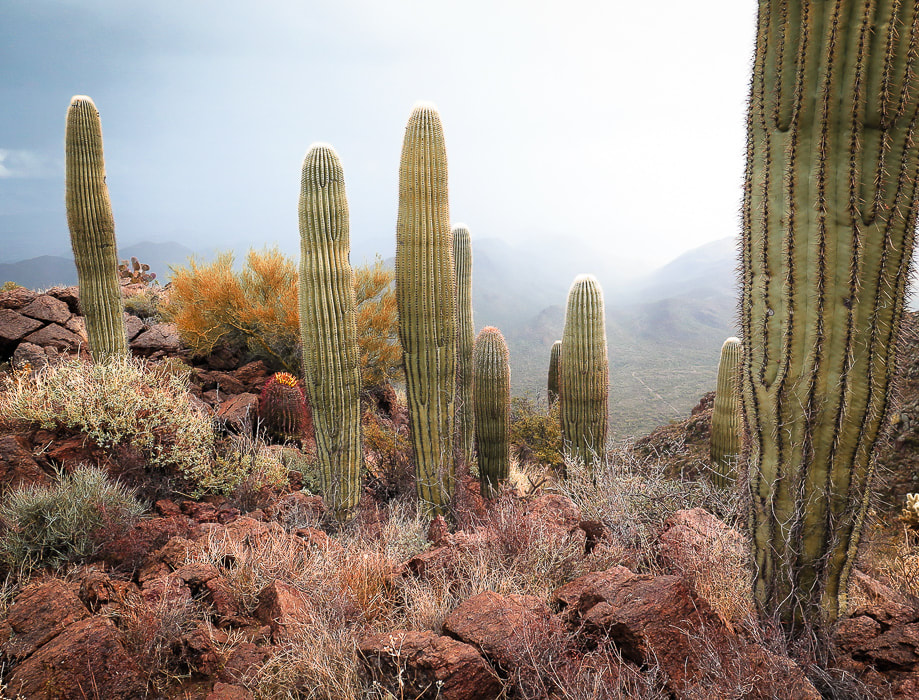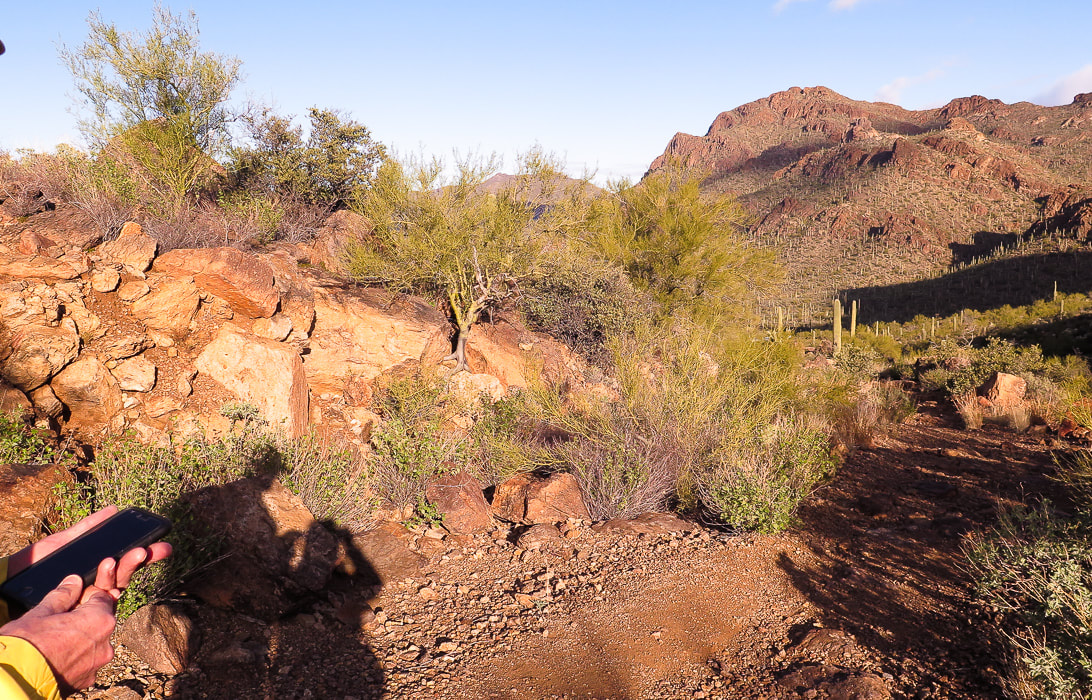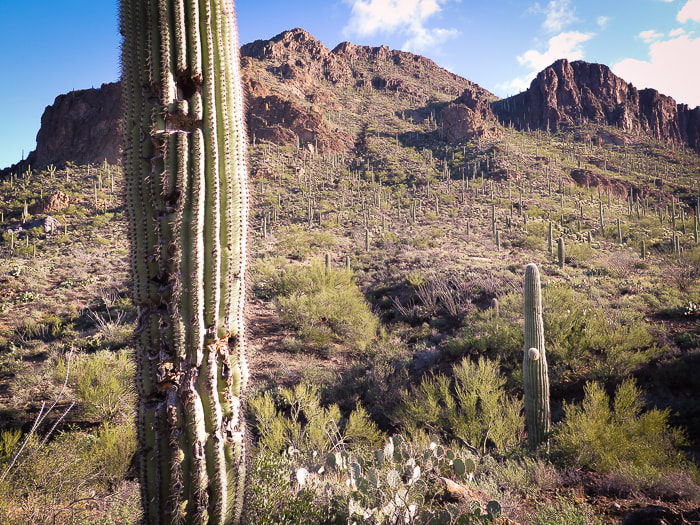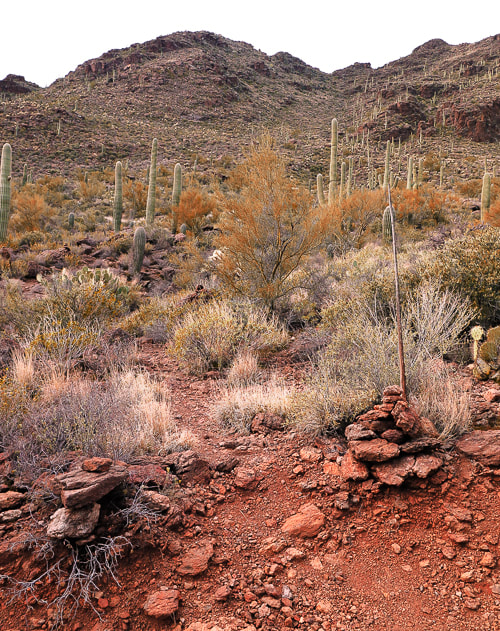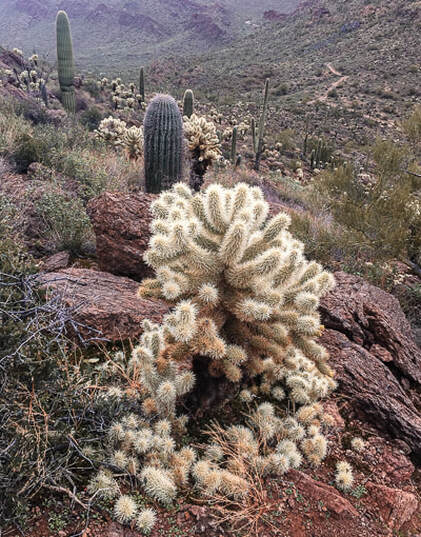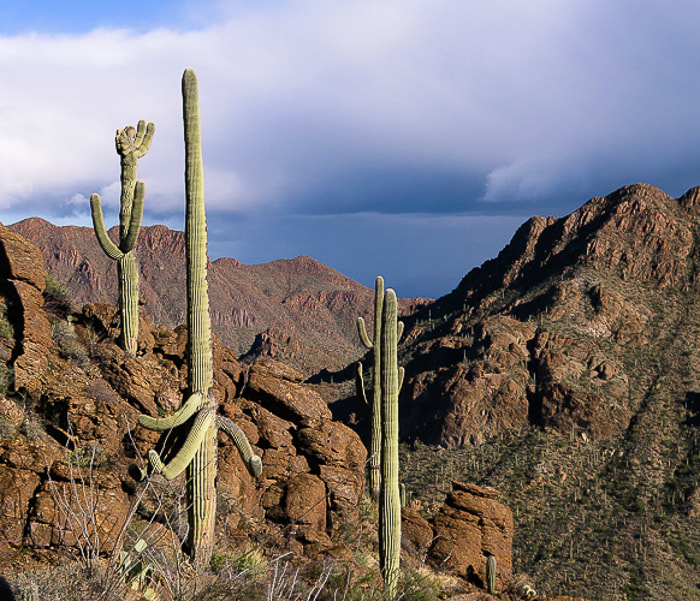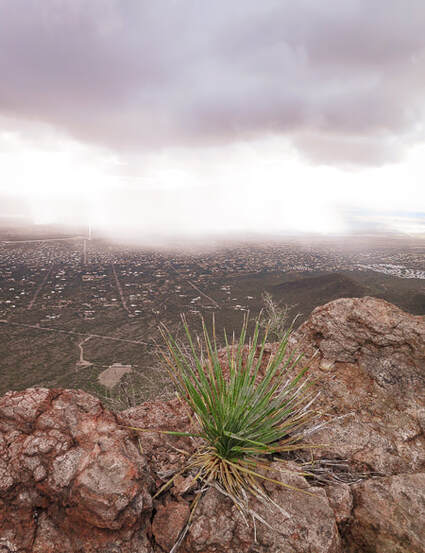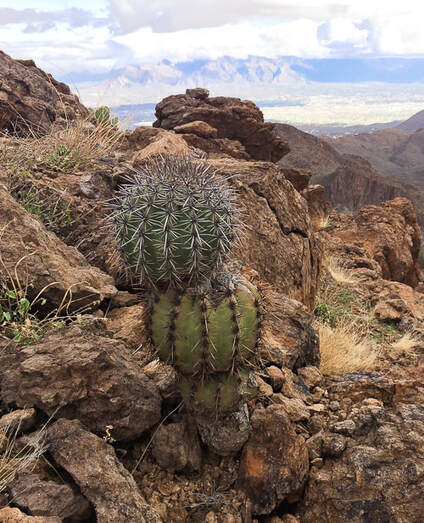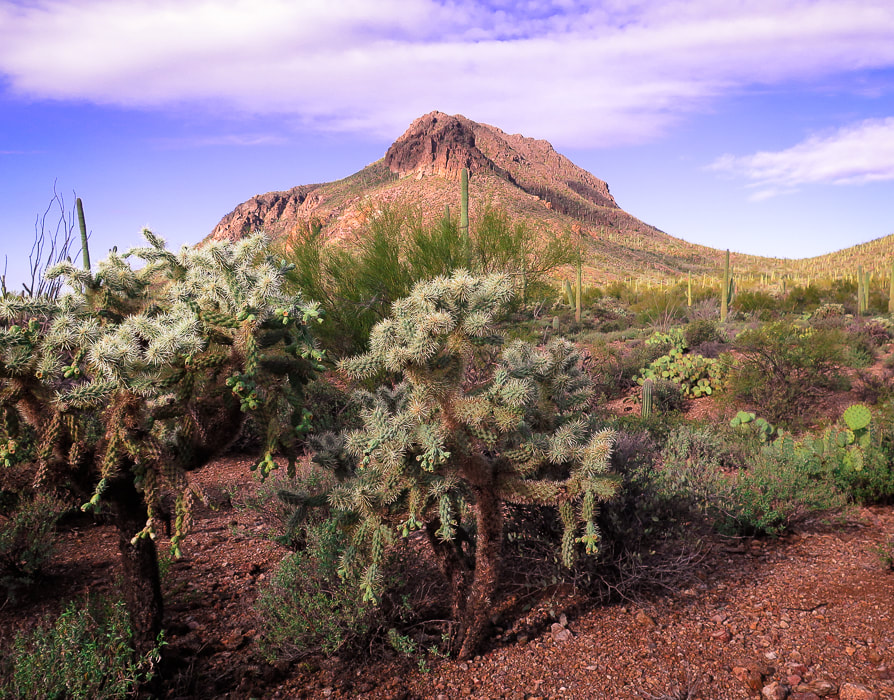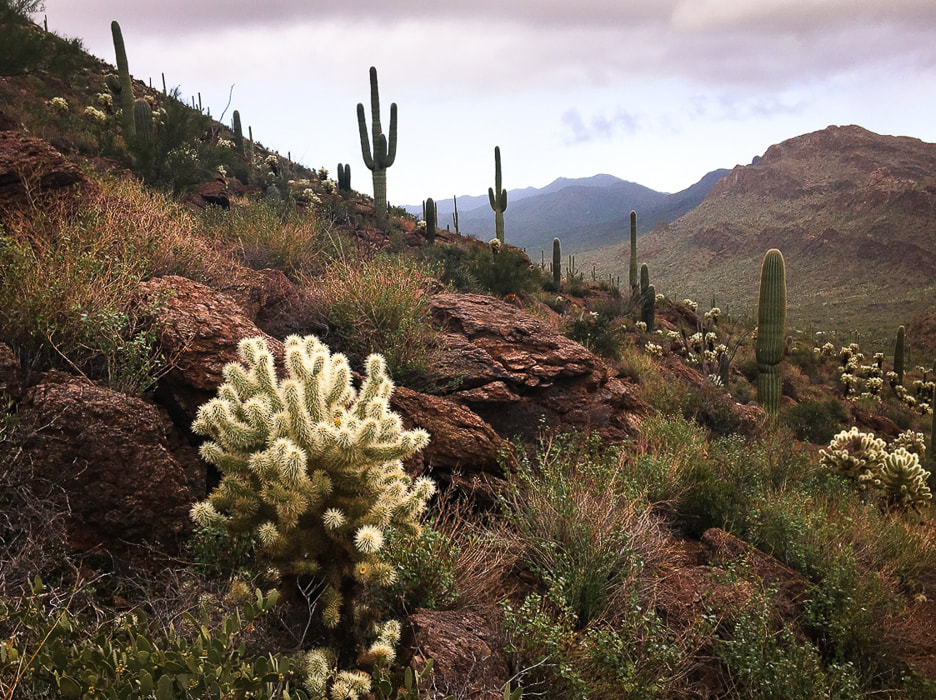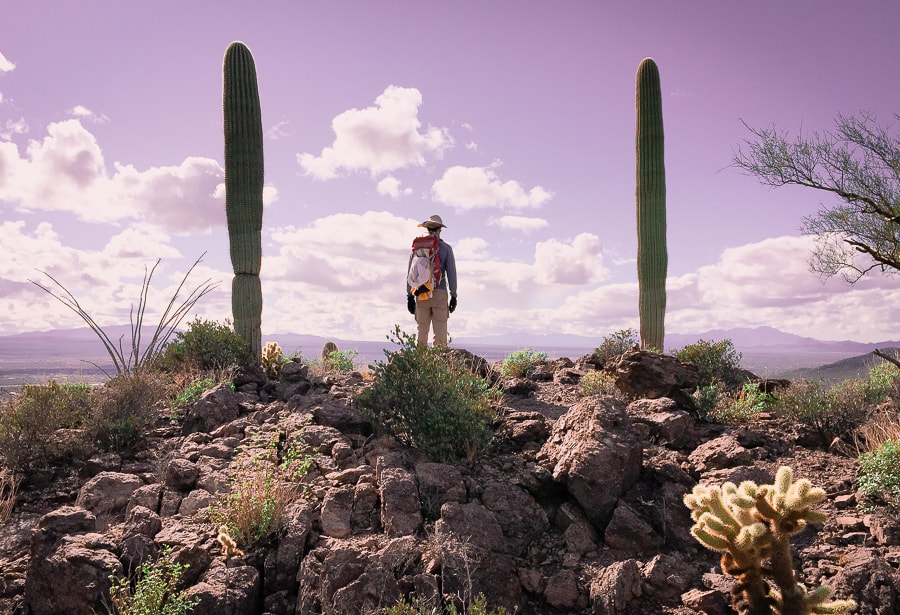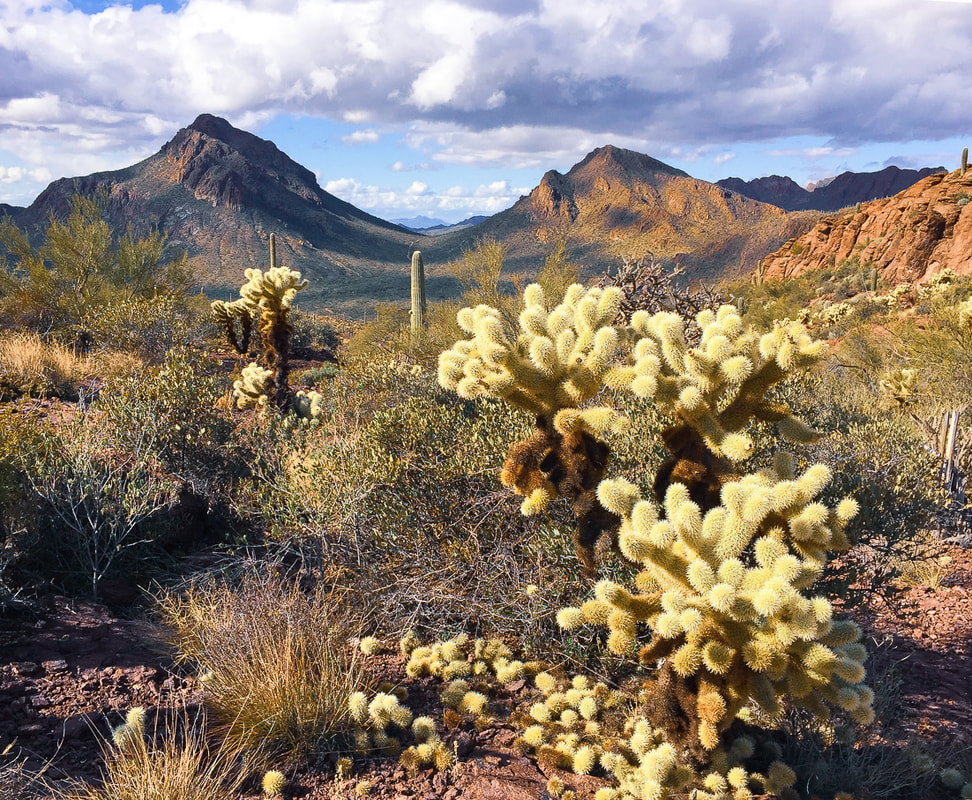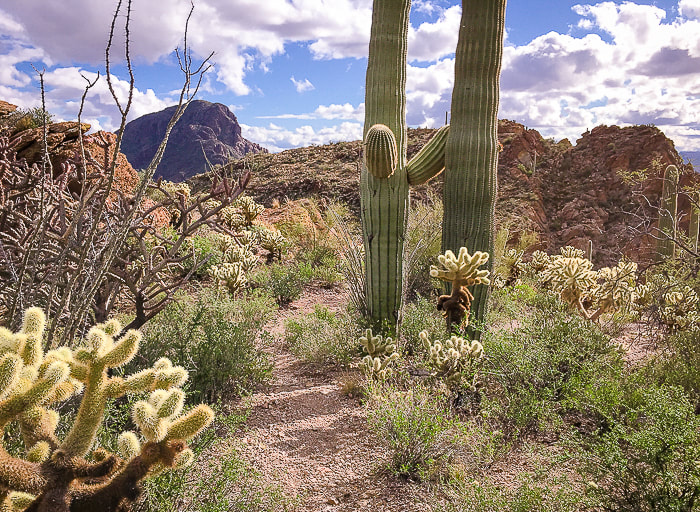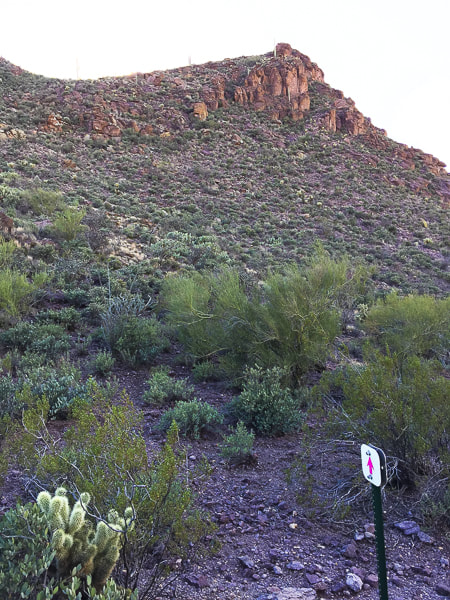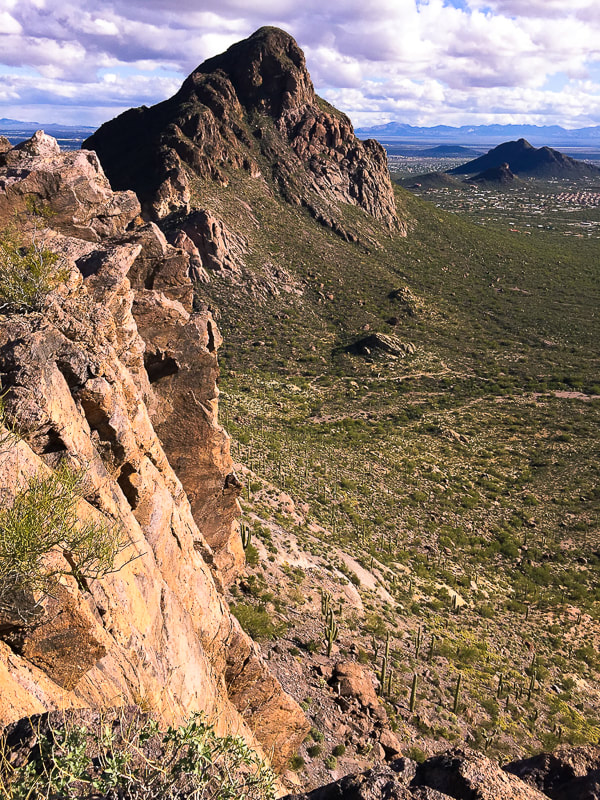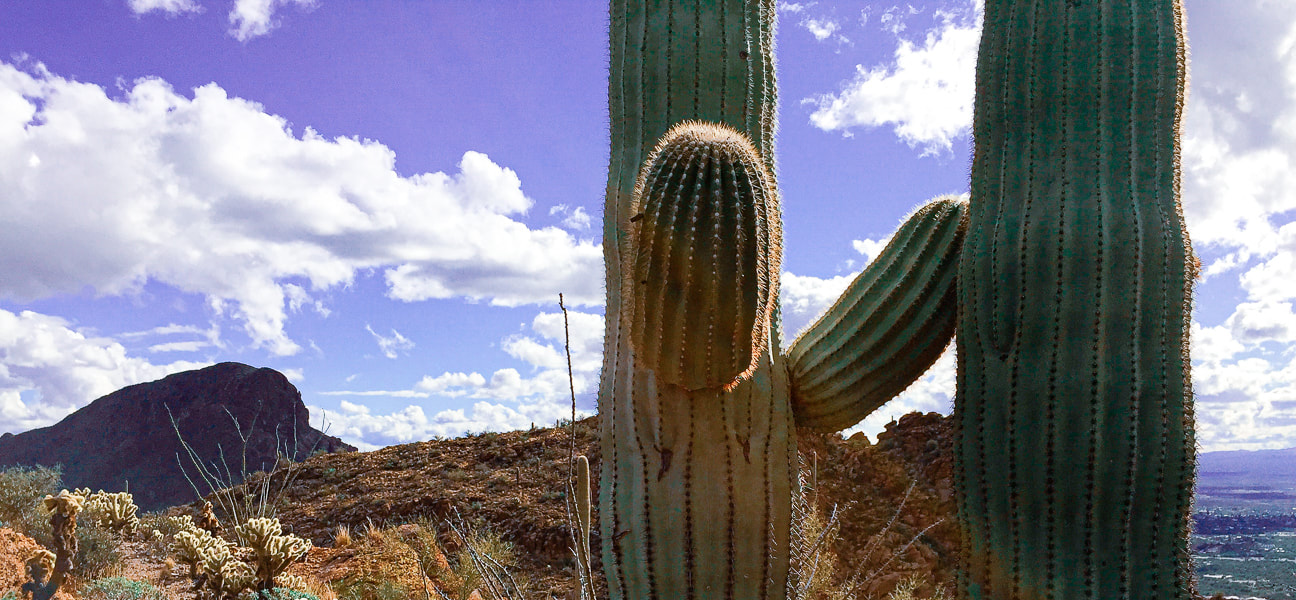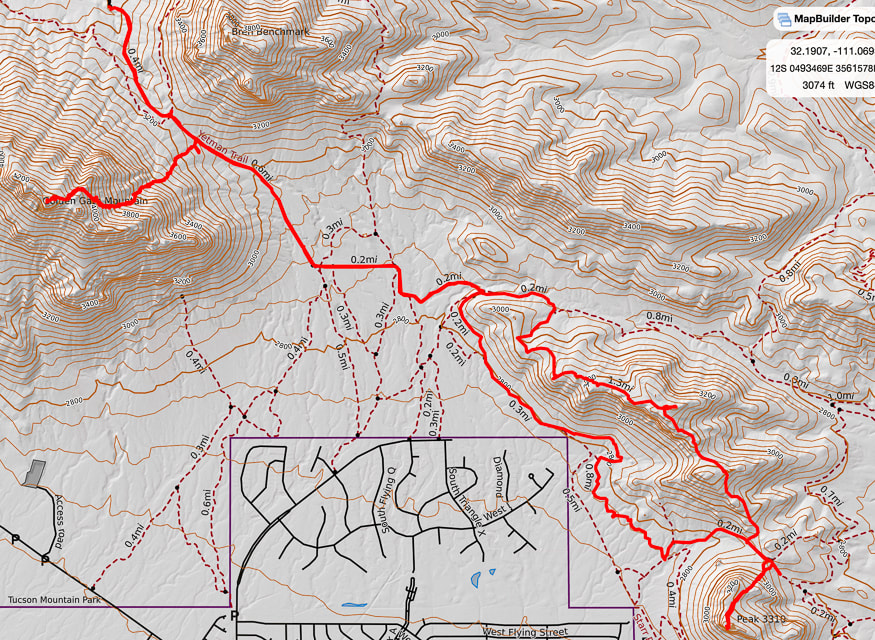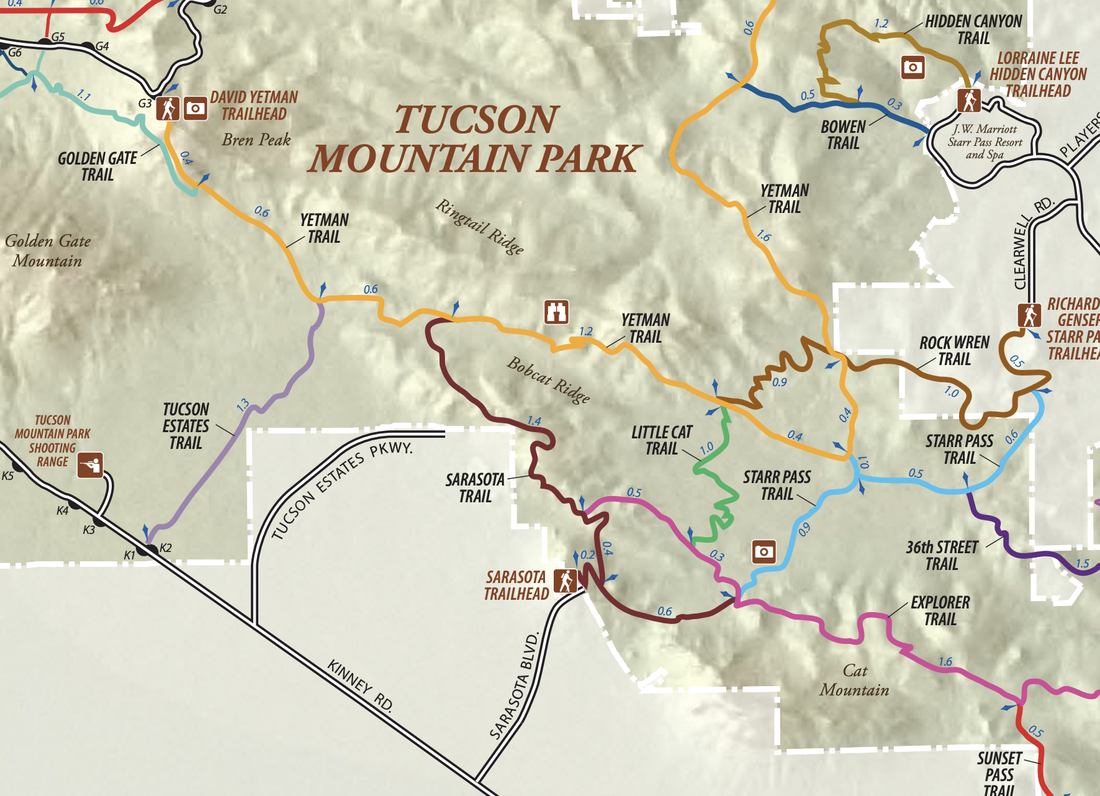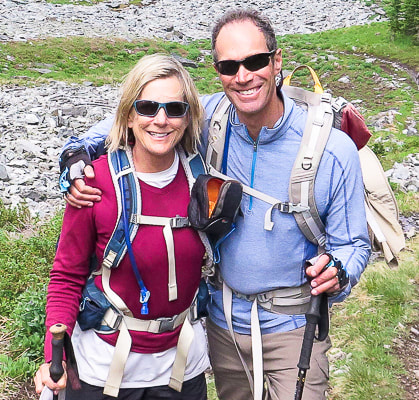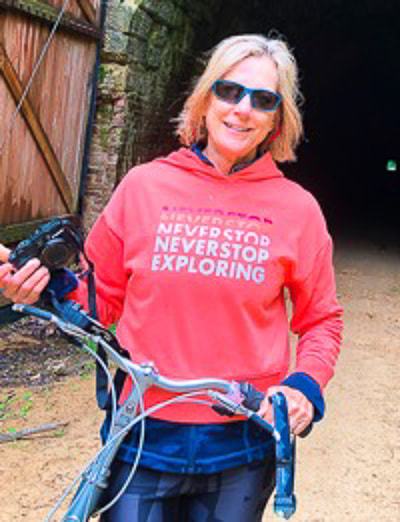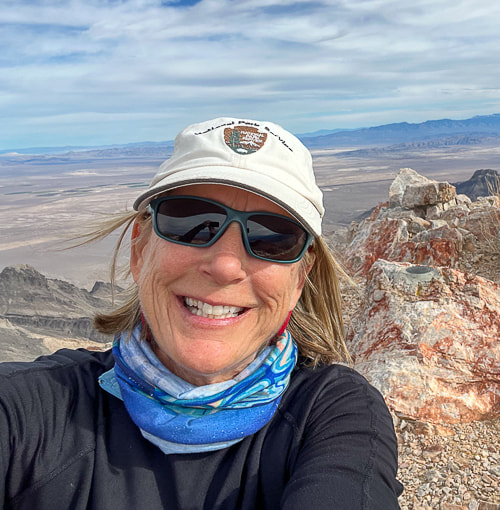|
Summit three scenic high points in the "Tucson Mountain Chaos" using a combination of established trails and off-trail climbs through exquisite Lower Sonoran desert ecosystem. Saguaros at Golden Gate Mountain summit Trip Stats
Overview: Close to Tucson, this mountain park feels almost like wilderness as trails wind through the colors, textures and dramatic mountain cliffs of volcanic peaks in prime Sonoran desert ecosystem. This tour uses established trails to access cross-country routes to peaks with spectacular views of southern Arizona's "sky islands". Location: Yetman trailhead, Tucson Mountain Park, Pima County, Arizona. Distance/Type: 9.25 miles out and back including a loop. Elevation gain: Total 3,130 feet. Highest point = Golden Gate Mountain at 4,288 feet. Difficulty: Easy to moderate Class 1 established trails; strenuous Class 1-2 cairned off-trail, navigation moderate. Maps: Saguaro National Park - Trails Illustrated #237. PDF of TMP Recreation Trails. Topo map our tracks below. Considerations: Great winter hike, carry plenty of water, no fees or trail register. No dogs allowed. Date hiked: Christmas day, 2019. Reference: We used Earthline's hike directions for this hike. Driving directions: From I-10 in Tucson, take Speedway Blvd West which turns into Gates Pass Rd. at intersection with Camino de Oeste. From this intersection, drive ~ 4.5 miles to Gates Pass Overlook, descend down ~0.4 miles past the pass: Yetman Trailhead is on the left in a large parking lot at a sharp right turn in the road. Geology: Tucson Mountains Caldera. High points are Cat Mountain Tuff (consolidated volcanic ash), valleys are landslide breccia deposits (referred to as Tucson Mountain Chaos). Hike Summary Golden Gate Mountain Summit, 4,288 feet- located on the right side of trail.
Yetman Trailhead and Golden Gate Mountain Our Hike It's not every day you can hike through valleys with rocks formally called "Tucson Mountain Chaos" and climb mountains made of compacted ash spewed from a huge volcanic eruption that created a 12-mile wide caldera whose floor collapsed onto an emptied magma chamber. At least this seems to be the current theory of the geologically complex Tucson Mountain Park. Geologists still debate and puzzle over the formation of this area. If you do this hike that I describe here, you will travel on the caldera floor through a beautiful Sonoran desert ecosystem. On this yearly Tucson visit, Fred and I were looking for different peaks in the area to summit. Not that we are tired of peaks in the Santa Catalinas and Rincon Mountains. A winter storm had dumped a lot of snow at elevations above 5,000 feet, so we opted for a warmer experience instead. Tucson Mountain Park is managed by Pima County. Its great website has an interactive map and lists features and activities in this 20,000-acre park that is "one of the largest natural resource areas owned and managed by a local government in the U.S." Outdoor activities range from picnicking to hiking, mountain bike riding and wildlife viewing. On Cat Mountain (a few days after this hike), we were lucky to see five grey Coues whitetail deer, atop steep and rocky rust-colored cliffs. I love celebrating holidays on the trail. There is a certain fellowship that occurs with greetings of "Merry Christmas" or "Happy New Year!" On this Christmas morning, the chill wind stung our faces, but it wasn't long before we felt warmth from the winter sun. The north walls of Golden Gate Mountain, the first summit of our Tucson Mountain Park tour Golden Gate Mountain At the Yetman trailhead, we set out to discover a new area with hike directions from Earthline. At the saddle between Golden Gate Mountain and Bren's Benchmark, 0.4 miles from the trailhead, we oriented ourselves and looked southeast to mountain summits, not yet knowing which ones we would be climbing. We took a right 0.1 miles past the saddle at the cairned trail that gains the Golden Gate through a break between cliffs, and began our climb to Golden Gate Mountain, our highest summit at 4,288 feet (see photo below). The golden color of the rocks perhaps gave this peak its name. Cat Mountain Tuff, a thick layer of consolidated ash, makes up the bulk of these peaks. Tucson Mountain Chaos is the term given by geologists to the rocks that underlie the Cat Mountain Tuff, seen in the valleys. There is no definite answer to the thousands-feet thickness of this Cretaceous-age tuff. Were these rocks below the Cat Mountain Tuff rafted from deeper levels by the rising magma? Or, was this rock caused by a landslide in a caldera that had accumulated the tuff? Of course, when you throw in the geometry of faulting that occurred later when Basin and Range was spreading, it makes the geologist's task of identifying the age relationship of the rocks more difficult. Dodging teddy bear chollas and barrel cactus spines, we marveled at a rare cristate saguaro thrusting up from a steep, south-facing slope under orange cliffs. Theories for the abnormal crest growth range from genetic mutations to lightning strikes. The trail threads between welded tuff towers and tops out, weaves to the left following cairns to the summit. Tucson spreads below, mountain ranges surround on the horizon. Below us, a white cloud moved across the valley and swept over us, briefly covering the peak with fog that created a rare, softly illuminated desert scene. Light rain produced vivid oranges, yellows and greens. Return to Yetman Trail via the same path. Cristate saguaro on left. Bren Benchmark across valley. Scenes from the summit of Golden Gate Mountain, Tucson Mountain Park View of Golden Gate Mountain from Yetman Trail (looking west). Yetman Trail runs through lowest point on saddle to the right. Peak 3,380' on Bobcat Ridge From return to Yetman trail, hike down-valley 1.15 miles to the intersection with the Sarasota Trail. Stay on Yetman to the left (east) for 0.2 miles to arrive at a flat saddle. Bobcat Ridge trail (not marked with signs but obvious) takes off to the right (southwest). The views of Tucson open up as you near the top, Peak 3,380'. It is a relaxed summit with beautiful vegetation, a favorite local hiker destination. From this summit, the steep northern walls of Little Cat Mountain comes into clear view; there's a lot of descending before the climb. To its left (southeast), the dark, enormous hulk that is Cat Mountain will have to be summited another day. Total mileage = 4.3 miles. Bobcat Ridge near Peak 3,380 From Bobcat Ridge looking northwest to saddle between Golden Gate Mountain (left) and Bren's Benchmark (right). The Yetman Trail traverses the saddle. Bobcat Ridge Trail leading away from Peak 3,380 toward Little Cat Mountain behind saguaros. Cat Mountain on the left. Little Cat Mountain From Peak 3,380, continue southeast on Bobcat Ridge Trail 0.7 miles to intersection with Explorer Trail; total mileage = 5.0 miles. Turn left (southeast) to climb to saddle in a short distance. At top of saddle, at arrow sign for Explorer Trail, hike up to saddle of Little Cat Mountain to the right (south). Fewer cairns than those of Golden Gate mark this off-trail approach which climbs a quick 400' to the summit, passing a relatively flat grassy area once the trail tops the saddle. From this summit, look to your left; an outrageous view of dark orange and black volcanic Cat Mountain appears as you stand on a cliff overlooking Tucson. The lowering sun and long shadows made this scene even more dramatic. We returned via our ascent to Explorer trail (signs with pink arrow), then made a loop around base of Bobcat Ridge by following Sarasota Trail (signs with maroon arrow), then finally on Yetman Trail to trailhead. Total distance: 9.25 miles. We vowed to climb Cat Mountain, then returned to its summit a few days later with our friend Scott, to celebrate the New Year and plan for hikes together in the beautiful southwestern deserts. Saddle near summit of Little Cat Mountain - faint trails ascend from this saddle between Bobcat Ridge and Little Cat on Explorer Trail. View of Cat Mountain from summit of Little Cat Mountain Cat Mountain on the left (we hiked that peak a few days later) Little Cat is behind the saguaro Our GPS tracks Trails in southeastern Tucson Mountain Park click on map for larger image References:
Lipman, P.W. 1994. Tucson Mountains Caldera: A Cretaceous Ash Flow Caldera in Southern Arizona. USGS Research on Mineral Resources 1994: Part B, Guidebook for Field Trips. U.S. Geological Survey. Tucson Mountains Geology: Complex and Controversial. Lipman, P.W. Geologic Map of the Tucson Mountains Caldera, Southern Arizona. Tucson Mountain Chaos. Arizona State Geology: Blog of the State Geologist of Arizona. Retrieved from internet. http://arizonageology.blogspot.com/2009/04/tucson-mountain-chaos.html
5 Comments
1/31/2020 01:39:03 pm
Amazing that this bit of pristine (appearing) terrain exists within a stone's throw from a major city. I'm sure the Teddy Bear Cholla presented daunting obstacles at times, but you sure transformed them into objects of beauty with your photographs.
Reply
It was surprising how Tucson Mountain Park felt kind of like wilderness - until you see Tucson spread below your feet - but it doesn't seem to impact this lovely area. It is well cared for! I will be back there hiking it someday! Thanks for your comment Linda! I actually did get a teddy bear cholla part that had fallen on the ground impaled into my calf. But it was when we were going cross-country to Cat Mountain's ridge. With the assistance of my fellow hikers, we got it free and all was well.
Reply
Awesome content. Loved this post and I’m definitely pinning it to share! You might like to visit Coupon plus deals for amazing coupons and promotion, especially for travel adventures, garments, gadgets, home and office supplies, and many more, with thousands of brands all over the world. Thanks for the great read. Kudos!
Reply
Leave a Reply. |
Categories
All
About this blogExploration documentaries – "explorumentaries" list trip stats and highlights of each hike or bike ride, often with some interesting history or geology. Years ago, I wrote these for friends and family to let them know what my husband, Fred and I were up to on weekends, and also to showcase the incredible land of the west.
To Subscribe to Explorumentary adventure blog and receive new posts by email:Happy Summer!
About the Author
|
